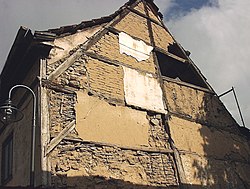Timber framing

Timber framing (German: Holzfachwerk) is a way to build buildings. Timbers are the structure of the building and fit together like a skeleton. Sometimes the timbers can be seen from the outside. This is called half-timbered. The spaces between the timbers are filled with brick, plaster, wattle or daub. These spaces are often for decoration. Germany is famous for half-timbered buildings.[1] There are also such buildings across Europe and in North America and Japan.[2] The building method is over a thousand years old and has many styles.

Timber Framing Media
The market square of Dornstetten, Germany, showing an ensemble of half-timbered buildings
Lemgo, Germany, downtown
A "true" or "full" cruck half-timbered building in Weobley, Herefordshire, England: The cruck blades are the tall, curved timbers which extend from near the ground to the ridge.
Interior of a two-aisled market hall, Chipping Campden, Gloucestershire, England
Half-timbered wall with three kinds of infill: wattle and daub, brick, and stone. The plaster coating which originally covered the infill and timbers is mostly gone. This building is in the central German city of Bad Langensalza.
Krämerbrücke in Erfurt, Germany, with half-timbered buildings dating from c. 1480
A variation of the second meaning of half-timbered: the ground floor is log and the upper floor is framed (half-timbered in the first sense). Kluge House, Montana, U.S.
Joints in an ancient French roof; the wooden pegs hold the mortise and tenon joinery together.
Projecting ("jettied") upper storeys of an English half-timbered village terraced house, the jetties plainly visible
References
- ↑ "Have You Heard of the German Half-Timbered House Road?". Outlook Traveller. Retrieved 2022-07-21.
- ↑ Cochran, Brice (2017-05-28). "The History of Timber Framing Around the World". Timber Frame HQ. Retrieved 2022-07-21.








